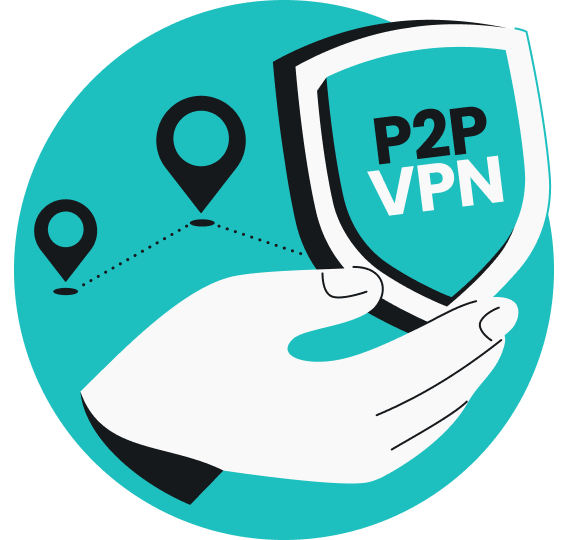Privacy-minded internet users are often uncomfortable with the idea of intrusive third parties tracking their browsing history or online actions.
Some turn to a VPN to secure their everyday surfing, while others look to Tor (The Onion Router). Still, another option is to combine the two and use the Onion over VPN technique.
What is Onion over VPN, and how does it work? Let this comprehensive guide illuminate you.
What is The Onion Router?
Let’s first tackle the Onion part of Onion over VPN.
The Onion Router is free, open-source software that enables anonymous online communication. It’s built using technology that’s interchangeably called the Onion network and the Tor network.
Users typically access the Onion network via the Tor Browser. This is maintained by the Tor Project, a volunteer-led nonprofit that aims to advance internet freedom and privacy.
How does The Onion Router work?
The idea of onion routing was originally developed by the US Navy, but it has since become popular among privacy enthusiasts. The Tor network uses onion routing to direct web traffic through multiple independent nodes or relays. There are three different kinds of Tor nodes:
- Entry node: this is where traffic enters the Onion network. A Tor entry node sees your real IP (Internet Protocol) address but doesn’t know where your web traffic is going;
- Relay nodes: these intermediary nodes move encrypted traffic through the Tor circuit. Relay nodes don’t know your web traffic’s source or destination;
- Exit node: this is where web traffic reaches its destination within the Tor network. Tor exit nodes see this destination but can’t trace traffic to your actual IP address.
These nodes offer different layers of encryption designed to keep your internet traffic and browsing history anonymous. However, since the Tor network depends on volunteers to oversee its nodes, your safety depends on each person’s goodwill. While several safe and useful dark web sites are available, problems like malicious exit nodes mean Tor’s anonymity is never guaranteed. On top of this, Tor often negatively impacts connection speeds, making it a subpar choice for daily use.
What is a VPN?
Now, on to the second part of the Onion over VPN equation — a VPN.
A VPN (Virtual Private Network) is an online privacy tool that encrypts your traffic and hides your IP address, creating a more secure and private internet connection. Unlike The Onion Router, a VPN encrypts all your traffic, not just traffic on a particular browser. This means your connection is protected no matter what you do on your device or what browser you use.
How does a VPN work?
A VPN works by encrypting your data before it leaves your device. The encrypted data is then split into packages and sent to a VPN server through an encrypted tunnel. Once your data reaches the VPN server, it’s decrypted and sent to the app or website you’re visiting.
As a result, your real IP is replaced with the VPN server’s IP address, making your traffic look like it’s coming from that server’s location. Since the most secure VPN providers use their own servers — not ones set up by a volunteer network — there is no risk of a faulty or malicious server set up by some bad actor.
What is Onion over VPN?
Onion over VPN, also called Tor over VPN, means connecting to a VPN server before jumping onto the Tor Browser. By doing this, you’re adding an extra layer of security to your internet connection and protecting it from potential threats posed by compromised servers within the Tor network.
How does Onion over VPN work?
By first booting up a VPN, you encrypt your data before it reaches a Tor entry node. As you surf on the Tor Browser, all traffic shows the VPN server’s IP address. Your regular IP is masked, and your traffic can’t be traced back to you — even after leaving the exit node.
So, you get end-to-end VPN protection on top of Tor’s privacy. As a result, your ISP (Internet Service Provider) can’t even see that you’re on Tor, only that you’re using a VPN (but top VPNs can obfuscate that, too).
What are the benefits of using Onion over VPN?
Well, browsing on the Onion network — sans VPN — comes with the following drawbacks:
- Compromised nodes: malicious actors can set up a faulty Tor exit node to intercept your data. The exit node is where Tor decrypts your web traffic, so it’s one of the Onion network’s most vulnerable points;
- Blocked websites: some pages block traffic from Tor exit nodes, making it harder for users to access websites or services they’re looking for;
- Malware infections: Tor offers access to the dark web, where many sites can infect your device with harmful viruses. The Onion network doesn’t have any antivirus software to protect against this.
One way to overcome these limitations is by using Onion over VPN.
Routing traffic through a VPN server keeps it encrypted, even if a node fails. Moreover, websites that typically block Tor traffic won’t detect that you’re using the Onion network. And leading VPN providers — like Surfshark — offer antivirus software to protect your devices against malware 24/7.
Why use Onion with Surfshark VPN?
If you prefer to use the Tor network for added anonymity, pairing it with Surfshark will improve your overall experience without getting in the way.
Surfshark’s infrastructure and privacy-focused tools complement Tor’s strengths, helping offset the Onion network’s biggest limitations, while preserving its core benefits.
A steadier connection for Tor traffic
Tor’s performance often depends on the stability of its volunteer-run nodes. Surfshark helps smooth out inconsistencies by giving you a fast, steady connection before your traffic enters the Onion network. This doesn’t eliminate Tor’s natural slowdowns, but it prevents issues caused by weak or unreliable local connections.
Protection around Tor’s weak points
Tor protects your identity through layered routing, but Surfshark adds an additional safeguard where Tor is most vulnerable: the entry and exit nodes. If a relay behaves maliciously or leaks information, Surfshark’s encrypted tunnel prevents the exposed data from revealing any sensitive information. This reinforces Tor’s design rather than replacing it.
Security outside the Tor network
Tor only handles traffic within the Tor Browser, while Surfshark secures what happens outside the Tor network — background apps, downloads, synced services — so your device doesn’t accidentally reveal information while you’re focused on your Tor activity. This keeps your overall privacy posture intact without requiring advanced configuration.
Surfshark features that address Tor’s limits
Some Surfshark tools provide advantages that Tor alone can’t offer without modifying your setup:
- Multi Hop: lets you choose custom entry and exit locations for an additional controlled encryption layer before Tor routing begins;
- Obfuscation: conceals the fact you’re using a VPN, which in turn makes your Tor usage even less detectable on restrictive networks;
- RAM-only servers: reduce the risk associated with persistent server logs, supporting Tor’s principle of minimizing traceable data.
- IP rotation: an optional feature that introduces extra variability in your connection without disconnecting from Tor, lowering the chance of long-term traffic correlation.
These features don’t replace Tor’s anonymity model — they strengthen it where Tor is inherently limited.
Increased resilience for regular Tor users
For people who rely on Tor regularly, Surfshark adds a layer of consistency and control that Tor alone cannot always guarantee. The result is a more stable, less frustrating, and more resilient Onion over VPN setup, all the while Tor’s privacy benefits stay fully intact.
Do you need to use Onion over VPN?
Most internet users don’t need to use Tor over VPN — a reliable VPN alone will offer enough privacy protection. Connecting to a VPN server already encrypts your traffic, hides your IP address, and keeps you secure online — without the extra hassle of dealing with the Tor network.
Here are the biggest pros and cons of using Onion over VPN:
|
Pros
|
Cons
|
|
Tor entry and exit nodes can’t see your IP address.
|
Using a provider with limited VPN server locations may compromise anonymity.
|
|
Your ISP can’t see you’re using Tor.
|
Combining the two can significantly reduce internet speeds.
|
|
You enjoy more private web surfing.
|
Setup can be complicated compared to using a VPN alone.
|
|
Your whole device is protected, even when you leave the Tor Browser.
|
Your device might consume more system resources, leading to slower performance.
|
With the above in mind, here are the main advantages of using a standalone VPN service instead of Onion over VPN:
- Faster speeds: a VPN encrypts your data without the multiple hops involved in the Onion network, resulting in a much faster browsing experience;
- Greater ease of use: VPN setup is designed to be user-friendly and doesn’t require as much technical knowledge as using the Tor network;
- Reliable security: VPN providers usually offer strong encryption and privacy protection. Advanced VPN security features in tools like Surfshark include a double VPN, kill switch, tracker blocking, and antivirus software to shield against malware;
- Broad compatibility: top VPNs work seamlessly with most websites, while many online services are blocked or restricted on Tor.
In sum, most of us don’t need to use Onion over VPN — if you’re already using a VPN service, it’s simply overkill. On the other hand, if you’re a diehard Tor user who prefers to be on the Onion network no matter what, then using Tor over VPN is much safer than visiting Onion sites without VPN protection.
How to use Onion over VPN
It’s not hard to use Tor with a VPN. You only need the Tor Browser and a trustworthy and secure VPN provider. Here’s a short guide using Surfshark as an example.
- Sign up for Surfshark: download the VPN app and install it.
- Launch Surfshark: log in and choose one of the 4,500+ available VPN servers. Connect and get your protection up and running.
- Download Tor: install the Tor Browser and open it to browse Onion over VPN.
Tor over VPN vs. VPN over Tor
What about VPN over Onion? This isn’t just a matter of semantics — VPN over Onion is technically different from Onion over VPN.
VPN over Onion involves turning on your VPN after connecting to the Tor network. This is useful for accessing specific websites that wouldn’t otherwise allow Tor connections, but that’s about the only benefit.
Using a VPN over Onion isn’t very common because it’s not exactly safe or easy. It forgoes the top reason for using Tor over a VPN — keeping your online identity secret. The entry or exit node can be compromised, and your ISP can now see you’re on the Tor network.
Onion over VPN vs. double VPN
Tor encrypts your data multiple times, while most VPNs only offer one encryption layer — unless they have a double VPN feature.
A double VPN feature, like Surfshark’s Multi Hop, encrypts your data twice — both times by your VPN provider — on two VPN servers. A double VPN boosts your online security even more, lets you choose your entry point and endpoint IP address, and reduces the risk of data leaks if one VPN connection fails.
In many cases, a double VPN is preferable to Onion over VPN.
Using Tor over VPN routes your internet traffic through a volunteer-built server network, which makes it possible for bad actors to intercept your data. In contrast, a double VPN routes traffic through two of its provider’s own servers, making your connection faster and more reliable — especially if the server infrastructure is independently audited.
Using Onion over VPN: the rundown
Tor over VPN can sometimes enhance online privacy, but you’re often doing double the work without getting double the security of relying on a VPN service alone.
For most internet users, a solid VPN connection is all that’s needed for greater privacy, freedom, and security on the web.
FAQ
Is Onion over VPN safe?
Onion over VPN is safer than using the Tor browser without the protection of a VPN. Tor uses servers set up by volunteers, and malicious actors sometimes use such servers to steal user data. Since a VPN encrypts your traffic before it leaves your device, it effectively protects you from hackers’ efforts.
Is Onion over VPN legal?
Yes, using Onion over VPN is legal in most countries. However, the legality of accessing Onion sites and certain content through the Tor network may vary depending on local laws. Always check your country’s regulations on VPNs and Tor traffic to ensure compliance.
Is Onion over VPN slow?
While most users see slower connection speeds while using Tor over VPN, much of this reduction is caused by using the Tor Browser. The Tor network’s use of multiple nodes can significantly slow your internet traffic, so adding a VPN for Tor won’t impact your connection much more.
What is Onion over a VPN used for?
Using Onion over a VPN gives your internet connection an extra layer of security and privacy. It doesn’t let your ISP know that you’re using Tor, and it hides your data from the first and last Tor node.
What’s better, double VPN or Onion over VPN?
A double VPN is generally better than Onion over VPN because it’s a more secure option. Tor’s exit nodes can be compromised if set up by malicious actors. However, a reliable double VPN (like Surfshark’s Multi Hop) routes browsing traffic through your VPN provider’s own servers, offering multiple encryption levels with a much lower chance of your data getting leaked.
Is Tor 100% untraceable?
No, Tor isn’t 100% untraceable — malicious nodes, software vulnerabilities, or sophisticated traffic correlation attacks can still expose users in some situations. Using a VPN with Tor can strengthen your privacy by masking your IP from entry nodes and keeping your Tor use private from your ISP, but it still doesn’t guarantee absolute anonymity.




